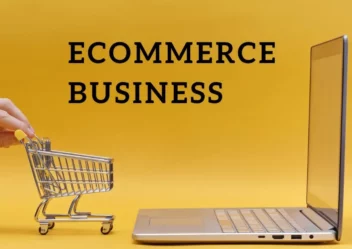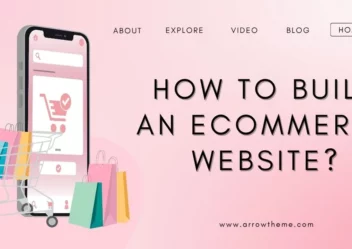What Is Headless Commerce? Smartest Move You Can Make
When looking at the major changes in e-commerce over the past decade, one concept that cannot be ignored is Headless Commerce. This is not just a trend but a revolutionary solution to the way businesses implement e-commerce to bring more flexibility and efficiency. It brings seamless shopping experiences to customers.
So, what is Headless Commerce, why is it considered a modern and flexible approach to e-commerce implementation? Let’s find out in the article below.
Claue – Clean and Minimal Magento Theme
We provide an amazing Magento theme with fast and responsive designs. Let’s find out!
What Is Headless Commerce?

Headless Commerce is an e-commerce architecture that separates the front-end (user interface, content, functionality, etc.) and the back-end (price database system, inventory management, etc.). This separation allows the frontend and backend to be built completely independently and connected to each other through eCommerce APIs (Application Programming Interface).
With Headless implementation, businesses can use any technology or tool they want to design and customize the user interface without being dependent on the e-commerce platform they are using. Businesses can also update and change the backend without affecting the frontend.
This model gives businesses the freedom to be creative in building unique storefront experiences that monolithic platforms typically cannot provide.
Benefits of Headless Commerce
Businesses turn to headless Commerce to gain flexibility, improve performance, and future-proof their online stores.
Provide Flexible Multi-channel Experiences
Technology has increased the trend of shopping as well as the level of customer engagement across multiple channels. Headless commerce supports a seamless shopping experience across multiple channels such as websites, e-commerce platforms, mobile apps, social networks, and even new technologies such as virtual reality (VR) and augmented reality (AR). Businesses can reach customers at multiple touchpoints without having to change the underlying system.
Easy Integration with Modern Technologies
Large enterprises often have many different sales channels with separate delivery requirements. They need a flexible and extensible data model, a powerful API mechanism to retrieve and manage data, along with an ecosystem of applications and integrations to support fast and flexible operations.
Headless commerce helps businesses achieve the above by easily integrating with important third-party technologies such as chatbots, AI, creating personalized experiences for customers, and being more consistent with brand identity.
Personalized Customer Experience
Headless commerce leverages customer data to deliver personalized shopping experiences, including product recommendations, interface customization, and relevant content. For example, businesses can display products that match each customer’s preferences and shopping behavior based on geographic location, shopping history, and previous interactions.
Headless commerce collects and aggregates customer data from many different sources, like CRM, advertising campaigns, or data from previous shopping experiences. Deploying Headless, businesses can create customized interfaces based on customer data and personal information.
Smooth, Fast Shopping Experience
Website page loading speed will also increase significantly when applying the Headless Commerce structure. Backend and frontend are no longer a unified entity but separate information storage places. Therefore, instead of having to load the entire website system at once, users only need to load the necessary categories thanks to the use of the API.
The amount of information users need to download will be significantly reduced, thereby maximizing the page loading speed. It improves the user experience, creating a smooth shopping experience, even when traffic spikes.
Flexible Customization
A big advantage of separating the parts is the clear division of tasks. When the front-end and back-end of the website are separated, development teams can work independently without worrying about affecting each other’s work, making the development process more flexible and faster.
Selling in International Markets
Implementing Headless Commerce is synonymous with the ability to expand business to international markets by tailoring business operations to serve different markets effectively. Specifically, businesses can customize the user interface, manage content, and separate views for each customer segment in each different market. At the same time, businesses can easily integrate payment options, shipping, language, and currency to optimize the local experience.
Optimized Performance
In a Headless architecture, the frontend and backend operate independently through APIs, so businesses can optimize the performance of both. For example, businesses can optimize the navigation and page load speed of frontends (websites, mobile apps, IoT) without depending much on the performance of the backend. Similarly, businesses can optimize the backend to handle product, transaction, or inventory requests efficiently without affecting the loading speed of the frontend.
Headless Commerce creates smooth, personalized shopping experiences for customers. Brands can retain customers before competitors.
At the same time, optimizing website speed also helps improve user experience, helping to increase conversion rates for e-commerce websites. In addition, fast page loading speed also has a positive impact on SEO, improving search rankings on search engines.
Speed Up Work Progress
Separating front-end and back-end means that development teams will work independently and faster. Therefore, businesses can test and deploy new features and updates quickly and easily customize the interface for each sales channel.
How Does Headless eCommerce Work?
The front end and the back end talk to each other through APIs. In this situation, we can understand APIs like little messengers that pass information back and forth.
1. The customer interacts with the front end.
Customer browses products, adds items to the cart, and checks out, all through the front-end interface.
2. APIs send the requests to the back end.
Every action (like adding to cart or placing an order) triggers an API call to the backend system. This backend holds all your data products, inventory, pricing, checkout logic, and customer info.
3. The backend processes the request.
The backend handles the heavy lifting: checking inventory, applying promotions, calculating totals, and processing payments.
4. The response comes back to the front end.
Once the back end finishes the task, it sends the result back to the front end. The customer sees the confirmation, updates, or next steps instantly.
Because the front end and back end are decoupled, you can update your storefront experience without touching the backend and vice versa.
How is Headless Commerce Different from Monolithic Commerce?
Before the Headless Commerce solution, most e-commerce websites were built with the Monolithic architecture. Monolithic architecture is when the frontend and backend are tightly linked together in a single system. This is a traditional and simple approach. Businesses will easily build and manage their e-commerce websites.
However, Monolithic Commerce has many limitations, especially when businesses want to develop and expand their e-commerce system. Some common problems when implementing Monolithic Commerce:
- Limited customization: Because the frontend and backend are connected, businesses will face many constraints when they want to redesign or add, or remove features to the website. Therefore, businesses have to customize both parts. It can lead to compatibility and performance issues.
- Limited scaling: When an e-commerce website has a significant increase in the number of products, transactions, and traffic, businesses need to upgrade and expand the system to meet the growth needs. However, with Monolithic architecture, this becomes difficult and costly because businesses will have to update the entire system. They may have to temporarily suspend the e-commerce website.
- Not meeting the need for innovation and competition: In the digital age, businesses need to constantly update new technology trends to innovate and improve e-commerce websites to attract and retain customers. However, with the Monolithic Commerce model, this needs to be done slowly and carefully. Because every small change can affect the entire system and can cause unexpected errors or problems.
In contrast to Monolithic Commerce, the Headless architecture brings many benefits to businesses when deploying an e-commerce website. Some of them are:
- Easy customization: In the Headless Commerce model, businesses are free to use their favorite technologies and development tools to build a comprehensive e-commerce system. In addition, businesses can easily change the frontend or backend without affecting the entire system’s overall operation.
- Easy to scale: With Headless Commerce, businesses can scale their website easily. Businesses can increase or decrease backend integrations based on their needs, or integrate with different sales channels to create multiple frontends (website, mobile app, IoT) that are operated on a single backend system via API. As a result, businesses reach more potential customers, increase conversion rates, and generate more sales.
- Easy to innovate and compete: With Headless deployment, businesses can innovate and improve their e-commerce website more quickly and flexibly. Businesses can freely experiment with new features or integration with many other third-party systems without worrying about compatibility and performance issues. In addition, businesses can apply the latest technologies to the website, such as artificial intelligence (AI), machine learning, virtual reality (VR) to provide optimal customer experiences.
| Monolithic Commerce | Headless Commerce |
| Limited customization | Easy to customize |
| Limited scalability | Easy to scale |
| Unable to meet the innovation and competition needs | Easily adapts to innovation and competition |
Is Headless Right for Your eCommerce Business?

Headless Commerce is a highly innovative modern e-commerce solution. However, that does not mean that this solution is suitable for all businesses. Therefore, before deciding to deploy Headless for an e-commerce website, businesses need to consider the following factors:
Business Goals
Businesses need to clearly define their business goals and consider whether Headless Commerce can help them achieve those goals. If the goal is to create a simple e-commerce website, the Monolithic architecture can still meet the requirements. It will be a more suitable choice. In case the business wants to bring customers a unique and seamless shopping experience across multiple sales channels, implementing Headless should be a priority.
Budget and Resources
Businesses should carefully calculate their budget and resources when implementing Headless Commerce. Because Headless implementation requires the use of eCommerce APIs to connect the frontend and backend together. Businesses will need a team of highly experienced and specialized technicians to design, develop, and maintain those APIs, as well as to meet complex customizations. Businesses also need to pay for API services, hosting, security, and integrations in use. Without enough budget and resources, businesses may encounter many difficulties and risks of failure when implementing this model.
Development Needs and Go-live Time
Headless architecture is quite complex, so it will take a lot of time to build, customize, and complete the e-commerce website, which can extend the expected go-live time. To avoid this risk, businesses need to schedule a detailed implementation for each task that needs to be completed.
In addition, businesses also need to regularly check and update APIs, frontend, and backend to ensure the system operates stably. Therefore, if businesses need to go live with the website quickly and do not have the need yet, if you adjust too many system settings, it is not necessary to deploy Headless Commerce at this time.
Which Businesses are Suitable for Headless Commerce?
Headless Commerce is especially suitable for businesses that:
Large-scale Businesses with High Customization Requirements
Headless Commerce will be suitable for large businesses that need to change the interface and customize continuously to meet market needs. The ability to separate frontend and backend makes it easy for businesses to change the interface without affecting the entire system.
Businesses That Want to Optimize Website Speed and Performance
Headless Commerce allows for optimizing page loading speed. This is an important factor in improving user experience and increasing SEO rankings. Headless Commerce will be the optimal choice for businesses that want to ensure their website always loads smoothly.
Businesses That Need to Integrate Multiple Systems and Services
With powerful integration capabilities via API, Headless Commerce is an ideal choice for businesses that need to link multiple systems, such as CRM, ERP, PIM, and other external services. This flexibility helps businesses easily adapt to new technologies and maintain high performance.
Multi-channel Businesses
Businesses that sell across multiple channels, like e-commerce platforms, websites, mobile applications, and social networks, will find Headless Commerce suitable. This model optimizes content across all devices and sales channels, providing a seamless shopping experience for customers.
Conclusion
Headless commerce brings us the flexibility to innovate faster, richer customer experiences, and stay competitive in a multi-channel world. However, going headless isn’t the best solution in every situation. Evaluate your current infrastructure, growth goals, and customer expectations to decide whether headless commerce is the right path forward.
Contact US – ArrowTheme:
– Email: [email protected]
– Facebook: Facebook.com/ArrowThemeTeam
– Website: ArrowTheme.com
Read more: Ecommerce Business: What Is It & Step by Step to Start



